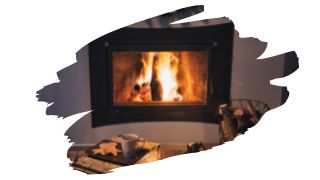Affordable and abundant, Tulip Poplar wood often crops up as a possible firewood choice.
The only problem? Tulip Poplar isn’t a very good option, if heating your home is of top priority.
So, what is it that makes for great quality firewood? And why does Tulip Poplar fall a little short on being used as anything more than kindling?
Well, in this post, you’ll learn what you should really be looking for when selecting good clean burning firewood. You will also discover how Tulip Poplar wood measures up as a firewood option.

This post may contain affiliate links to products that we receive a commission for (at no additional cost to you). Learn more here.
What’s The Best Type Of Firewood?
If you want firewood for an indoor fireplace, it should produce very little smoke. Which means that good firewood needs to be fairly dry (and contain very little moisture).
It should also contain very little tree sap or pitch. And, it should be fairly dense too, since dense woods will burn longer and produce more heat.
So, dense hardwoods such as White Oak and Birch wood, make for fantastic fuel options for your fireplace. And provided they’ve been given time to dry out, they’ll produce very little smoke too.
Related Post: Is Acacia Wood A Good Choice For Firewood?
What About Smoke? How Do You Minimize Smoke Emissions?
Well, when there is a lot of moisture in a piece of wood, it will produce a lot of smoke. That is because the moisture will vaporize into steam as that log burns. And that extra steam adds to those emissions, turning smoke into thick lung-clogging fumes.
So, the best way to keep smoke to a minimum, is to simply allow wood to dry out before you use it. This is called ‘seasoning’. And seasoning involves letting freshly logged wood dry for a number of months.
You see, when wood is first cut, (otherwise known as green wood), it has a moisture content of around 100%. However, if you let it dry for 6-12 months, that moisture content will drop down to less than 20%.
And it’s when wood is very dry that it’s ready for the fire.
You can learn more about seasoning wood, by checking out our post here: How To Season Wood (7 Tips)
What Is Moisture Content Again?
Moisture content simply measures the percentage amount of water in any given piece of wood.
You can check woods moisture content using a device called a Moisture Meter.

And What Kind Of Wood Absolutely Should Not Be Burned In A Fireplace?
Avoid using any wood that comes from poisonous trees or sap-saturated timber;
A). Do Not Burn Timber From Poisonous Trees
Trees that have poisonous (or otherwise toxic) compounds in them, have no place in an indoor fireplace.
Those compounds can gather in the soot and fumes produced by burning these timbers. And no home needs that stuff collecting around the place.
B). Do Not Burn Timber From Sap/Pitch Resin Filled Logs
Trees that have a lot of sap/pitch in them, (such as Cedar and Pine), pose a fire hazard.
That’s because tree sap/pitch can collect in the soot lining your chimney flue. And if enough of it gathers there, it can block the chimney itself. This, in turn, can cause chimney fires.
Related Post: Is Pine Wood Good For Smoking Meat?
Good To Know… So, What Does All Of This Mean For Tulip Poplar Firewood?
On the face of it, Tulip Poplar (also known as Yellow Poplar), looks to be a good firewood choice.
It is not a poisonous tree species, and it doesn’t contain lots of tree sap/resin. So, it should be good enough to heat your home — right?
Well, not quite. You see, there is one key criteria for firewood that the Tulip Poplar fails on, and that is density.
The Tulip Poplar is a fairly low density lumber. There isn’t much substance to it when you compare it to more popular firewood options in the form of Oak or Birch. And it’s low density is reflected in the amount of heat produced by burning Tulip Poplar wood.
According to the BTU (British Thermal Unit), the tulip popular is little more than kindling compared to Oak. You see, the British Thermal Unit measures the amount of energy it takes for fire to consume firewood.
The higher the BTU of wood, the more energy it takes to burn a piece of wood. And the more energy it takes, the more heat is generated.
Now, the Tulip Poplar only ranks a low 16.0 BTU when you use it as firewood. Which is nothing when you compare that against White Oaks 25.7 BTU, and Birch woods 23.6 BTU rating.
But Can You Still Use Tulip Poplar In A Fireplace Anyway?
Of course you can. Tulip Poplar will catch light and burn with the best of them.
However, if you want to actually warm up your home, you need a firewood that has a little more substance.
In other words, this tree is a great choice for kindling. Nonetheless, as a serious option for home fuel, the Tulip Poplar falls way short.
Related Post: Here’s Why Sealing Poplar For Outdoor Use Doesn’t Really Work
To Wrap Up, Here Are The 3 Key Takeaways From This Post…
- 1). Good firewood needs to be fairly dense, so that it can create a good amount of heat when it burns.
- 2). Tulip Poplar wood is fairly low density for a hardwood. And it doesn’t produce much heat compared to other firewood options.
- 3). White Oak and Birch wood are much better firewood choice for heating up your home.
References:
Wood Smoke Awareness | EPA.gov



